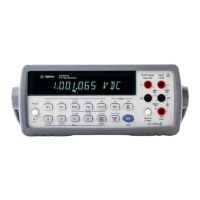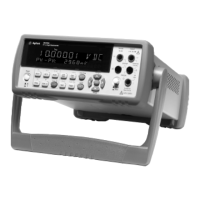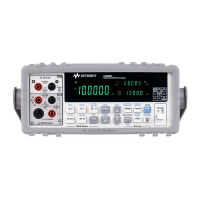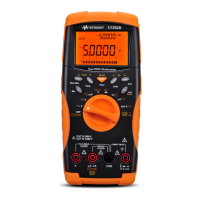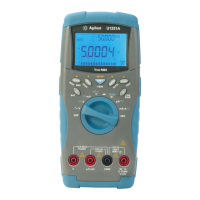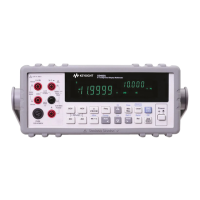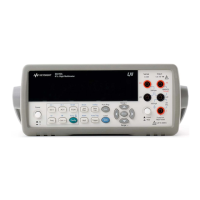98 Chapter 4 Making Measurements
10 OPTION BASE 1 !COMPUTER ARRAY NUMBERING STARTS AT 1
20 DIM Rdgs(200) !DIMENSION ARRAY FOR 200 READINGS
30 OUTPUT 722;"PRESET NORM" !TARM AUTO, TRIG SYN, DCV AUTORANGE
40 OUTPUT 722;"NRDGS 200,AUTO" !200 READINGS/TRIGGER, AUTO SAMPLE EVENT
50 OUTPUT 722;"MEM FIFO" !ENABLE READING MEMORY, FIFO MODE
60 OUTPUT 722;"TRIG SGL" !TRIGGER READINGS
70 PAUSE !PAUSE PROGRAM, PRESS CONTINUE TO RESUME
80 ENTER 722;Rdgs(*) !ENTER READINGS
90 PRINT Rdgs(*) !PRINT READINGS
100 END
Sending Readings Across the Bus
This section describes the output formats for readings and how to transfer
readings from the multimeter to the controller.
Output Formats The multimeter sends readings to the GPIB output buffer whenever readings
are being taken and reading memory is not enabled (MEM OFF command).
(In thepower-on. RESET, or any of the PRESET states, reading memory is
not enabled.) The five output formats and the number of bytes per reading are:
ASCII -- 15 bytes per reading
SINT -- 2 per reading
DINT -- 4 bytes per reading
SREAL -- 4 bytes per reading
DREAL -- 8 bytes per reading
• ASCII This is the most commonly used output format because it has no
scale factor and requires no special handling by the controller to convert
the data. Since ASCII uses the greatest number of bytes per reading, use
this format when measurement speed is not critical.
Note When using the ASCII format, 2 additional bytes are required for the
carriage-return, line-feed (cr, lf) end of line sequence. The cr, lf is used
only for the ASCII format and normally follows each reading output in
ASCII format. However, when using the ASCII output format and
multiple readings are recalled from reading memory using the RMEM
command, the multimeter places a comma between readings (comma =
1 byte). In this case, the cr, lf occurs only once, following the last reading
in the group being recalled. Commas are not used when readings are output
directly to the bus (reading memory disabled), when readings are recalled
using “implied read”, or when using any other output format.
• Single Integer (SINT) or Double Integer (DINT) Use the SINT format
when making low-resolution measurements (3.5 or 4.5 digits) at the highest
possible rate on a fixed range (autorange disabled). (Since the SINT format
is only 2 bytes per reading, readings can be transferred across GPIB faster
using SINT than any other format.) Use the DINT format when making
high-resolution measurements (5.5 digits or greater) at the highest possible
speed on a fixed range.
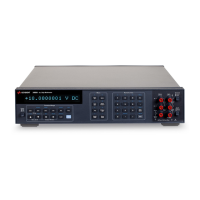
